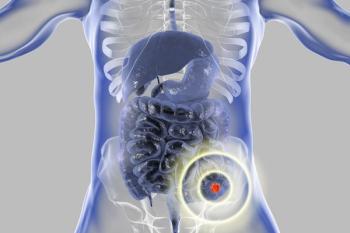
Oncology NEWS International
- Oncology NEWS International Vol 14 No 8
- Volume 14
- Issue 8
Adding Bevacizumab to FOLFOX4 Improves Survival in Metastatic Colorectal Cancer
ORLANDO-“Adding highdosebevacizumab (Avastin) to FOLFOX4improves overall survival, diseaseprogression-free survival (PFS),
ORLANDO-"Adding highdosebevacizumab (Avastin) to FOLFOX4improves overall survival, diseaseprogression-free survival (PFS),and response in previously treated patientswho have advanced colorectalcancer," Bruce J. Giantonio, MD, reports.Dr. Giantonio of the Universityof Pennsylvania, Philadelphia, presentedresults of the Eastern CooperativeOncology Group (ECOG) E3200 studyat the American Society of ClinicalOncology 41st Annual Meeting (abstract2).Survival Benefits"The addition of bevacizumab toFOLFOX4 resulted in a statisticallysignificant improvement in overall survival(OS). At a median follow-up of28 months, the median OS for thosetreated with FOLFOX4 plus bevacizumabwas 12.9 months vs 10.8 monthsfor FOLFOX4 alone (P = .0018; hazardratio [HR] for death, 0.76). Themedian OS for patients treated withbevacizumab alone was 10.2 months,"Dr. Giantonio said. FOLFOX4 plusbevacizumab also significantly increasedPFS (7.2 months vs 4.8 months;P < .0001; HR for disease progression,0.64). The median PFS with bevacizumabalone was 2.7 months. RECISTcriteria showed 21.8% confirmed responseswith the combination vs 9.2%with FOLFOX4 alone and 3% withbevacizumab alone.E3200 was a randomized, phase IIItrial of high-dose bevacizumab (10mg/kg, IV, biweekly) either alone or incombination with FOLFOX4. ThisFOLFOX regimen includes biweeklyoxaliplatin (Eloxatin; 85 mg/m2 onday 1); leucovorin (200 mg/m2 IV2 hours), and fluorouracil (5-FU;400 mg/m2 IV bolus followed by600 mg/m2 by continuous IV infusionfor 22 hours on days 1 and 2). Thecombination was compared with FOLFOX4alone and initially also with bevacizumabalone in 829 patients randomizedamong the three arms.
The rationale for testing bevacizumabin this combination is that the hu-manized monoclonal antibody inhibitsangiogenesis by binding vascularendothelial growth factor (VEGF) andhas improved survival when combinedwith chemotherapy for advanced colorectalcancer in previous studies.The primary endpoint was OS, andthe study was powered to detect a 40%improvement when bevacizumab wasadded to FOLFOX4. Prior treatmentwith a fluoropyrimidine and an irinotecan(Camptosar)-based regimenused either alone or in combinationwas required. Prior bevacizumab usewas not allowed.Interestingly, bevacizumab appearsto be inactive as a single agent in thispreviously treated population. In February2003, the ECOG Data MonitoringCommittee recommended closingthe bevacizumab-alone arm becausesurvival in that arm was nearing apredetermined boundary suggestinginferiority when compared with thechemotherapy-containing arms.Hypertension Linked toBevacizumabThe adverse effects of most concernwere hypertension, peripheralneuropathy, and hemorrhage (Table1). Dr. Giantonio suggested that theincreased rates of grade 3-4 sensoryneuropathy seen in the bevacizumabarms might be a function of increasedtime on treatment for these patients."Sensory neuropathy is a known adverseeffect of oxaliplatin, the incidenceand severity of which increasewith the drug's use," he said. Patientsrandomized to receive FOLFOX4 plusbevacizumab had a median durationof therapy of 10 cycles vs 7 cycles forthose on the FOLFOX4 arm and 4cycles for those on the bevacizumabalone arm.Hypertension has been previouslyassociated with bevacizumab use, andDr. Giantonio noted that this associationalso was demonstrated in E3200.Although bleeding was infrequent, astatistically significant difference inbleeding events was also noted for patientswho received FOLFOX4 plusbevacizumab. There were 10 bleedingevents in patients on that arm of thestudy, 9 of which were grade 3. Theseevents included eight cases of gastrointestinalbleeding, one case ofbleeding from a biliary tumor witherosion into a portal vein, and onecase of bleeding following surgery thatrequired a transfusion.Dr. Giantonio concluded, "Bevacizumabat 10 mg/kg in combinationwith FOLFOX4 improved OS, PFS,and response for previously treatedpatients with advanced colorectal cancer.Bevacizumab and FOLFOX4 werewell tolerated."The discussant for this paper wasLee Ellis, MD, of the University ofTexas M.D. Anderson Cancer Center,Houston. Dr. Ellis said, "Responserates are increased with the additionof bevacizumab to chemotherapy. Inlooking across the bevacizumab pluschemotherapy trials (in several typesof cancer), there is a 10% improvementin response rates when you addbevacizumab."
Articles in this issue
over 20 years ago
Intermittent Erlotinib With Docetaxel Shows Promise in NSCLCover 20 years ago
Erlotinib Shows Early Activity in Liver Cancerover 20 years ago
Erlotinib Shows Promise as First-Line Therapy, Phase II Data Showover 20 years ago
Bevacizumab/Erlotinib CombinedBoost Responses in Renal Cell CaNewsletter
Stay up to date on recent advances in the multidisciplinary approach to cancer.





